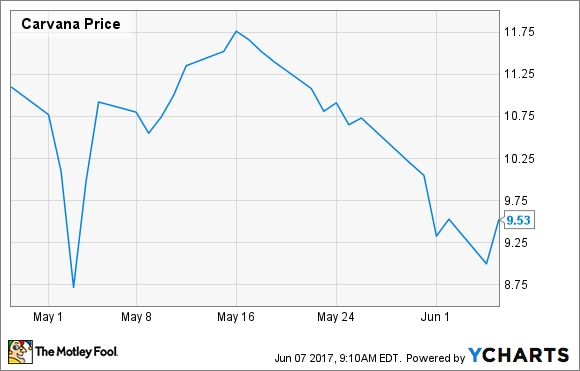Newly public Carvana Co. (CVNA 0.11%), which sells used cars online and delivers them via distinctive "vending machine" retail facilities, reported on June 6 that its first-quarter loss widened to $38.4 million on revenue of $159.1 million. Excluding some costs, Carvana's net loss was $0.28 per share. That beat expectations: Wall Street analysts polled by Thomson Reuters had expected a loss of $0.29 per share on revenue of $157.7 million.
Carvana earnings: The raw numbers
| Metric | Q1 2017 | Change vs Q1 2016 |
|---|---|---|
| Revenue | $159.1 million | 118% |
| Retail units sold | 8,334 | 120% |
| Gross profit | $9.7 million | 146% |
| Gross profit per unit sold | $1,169 | 11.8% |
| EBITDA margin | (21.6%) | 9.0 ppts improved |
| Net profit (loss) | ($38.4 million) | Loss increased by $21.1 million |
Data source: Carvana Co. "Ppts" = percentage points. "EBITDA margin" is a non-GAAP metric: EBITDA (earnings before interest, tax, depreciation, and amortization) as a percentage of revenue.
Carvana opened two new retail sites, or "markets," during the first quarter. It had a total of 23 markets as of March 31, 2017.

Carvana opened this brick-and-mortar "market" in Houston, Texas in December. Buyers can choose to have their new vehicles delivered, or to pick them up from the distinctive "vending machine" tower. Image source: Carvana Co.
About Carvana and its vending machines
Phoenix-based Carvana describes itself as "a leading eCommerce platform for buying used cars." The company was spun off from a privately owned car-dealership group, DriveTime Automotive Group, in 2014. It went public on April 28, 2017.
While its primary presence is online, Carvana is known for its distinctive brick-and-mortar retail sites, which it refers to as "markets." The markets feature glass "vending machine" towers that display -- and dispense, after a special oversize "coin" is deposited -- vehicles in inventory. The vending machines may seem whimsical, but there's a good business case for them: The distinctive experience helps differentiate Carvana from local used-car dealers, as well as from heavy-hitting rivals like CarMax (KMX -0.67%) and eBay's (EBAY 1.09%) eBay Motors.
After Carvana's customers purchase their vehicles online, they can choose to have the new vehicles delivered, or to pick them up from one of the company's vending-machine facilities.
Carvana as an investment
Carvana's initial public offering was priced at $15 a share, but it fetched just $13.50 when it opened on the New York Stock Exchange on April 28. The ride since then has been a decidedly bumpy one.
CVNA data by YCharts. Carvana's stock price is shown from its initial public offering on April 28, 2017 through market close on June 6, 2017. Carvana's first-quarter earnings results were released after the market closed on June 6.
Investors have some real concerns. For starters, Carvana is burning cash quickly as it rushes to open more brick-and-mortar dealerships. And it's getting into the used-car business at a difficult time: Used-car prices have been falling for months as the market has struggled to absorb a glut of off-lease vehicles, the result of a boom in new-vehicle leasing that began earlier this decade.
But with the U.S. new-car market likely past its cyclical peak, and average new-car prices near all-time highs, there's a good chance that demand for used vehicles will pick up over the next year or two. With its distinctive branding and customer experience, Carvana could see significant growth.
What Carvana's CEO had to say
In a statement accompanying Carvana's first-ever earnings release, CEO Ernie Garcia talked up the company's opportunity:
We are excited to announce record revenue in our first earnings report as a newly public company. Our strong performance this quarter reflects a significant increase in retail units, as well as expansion into new markets. During the quarter, we made important enhancements to the customer experience through new product development, resulting in ongoing optimization from website through vehicle delivery.
We continue to see increased consumer adoption of online car buying across our markets, charting a clear path to consistent growth within the $710 billion U.S. used auto market. Carvana's unique business model includes proprietary technology and assets, like the vending machines, that deliver customer experiences that position us to execute against our aggressive growth plans.
Looking ahead: Carvana's guidance for the second quarter and full year
Carvana expects its second-quarter results to shape up as follows:
- Retail unit sales of 10,000 to 10,500.
- Total revenue between $193 million and $203 million.
- Total gross profit per unit of $1,375 to $1,425.
- EBITDA margin between (18%) and (18.5%).
For the full year, Carvana expects:
- Retail unit sales of 44,000 to 46,000 versus 18,761 in 2016.
- Revenue of $850 million to $910 million versus $365 million in 2016.
- Total gross profit per unit of $1,475 to $1,575 versus $1,023 in 2016.
- EBITDA margin of (14%) to (16%) versus (23.2%) in 2016.
- 16 to 18 new market openings, to a total of 37 to 39 at the end of 2017.






